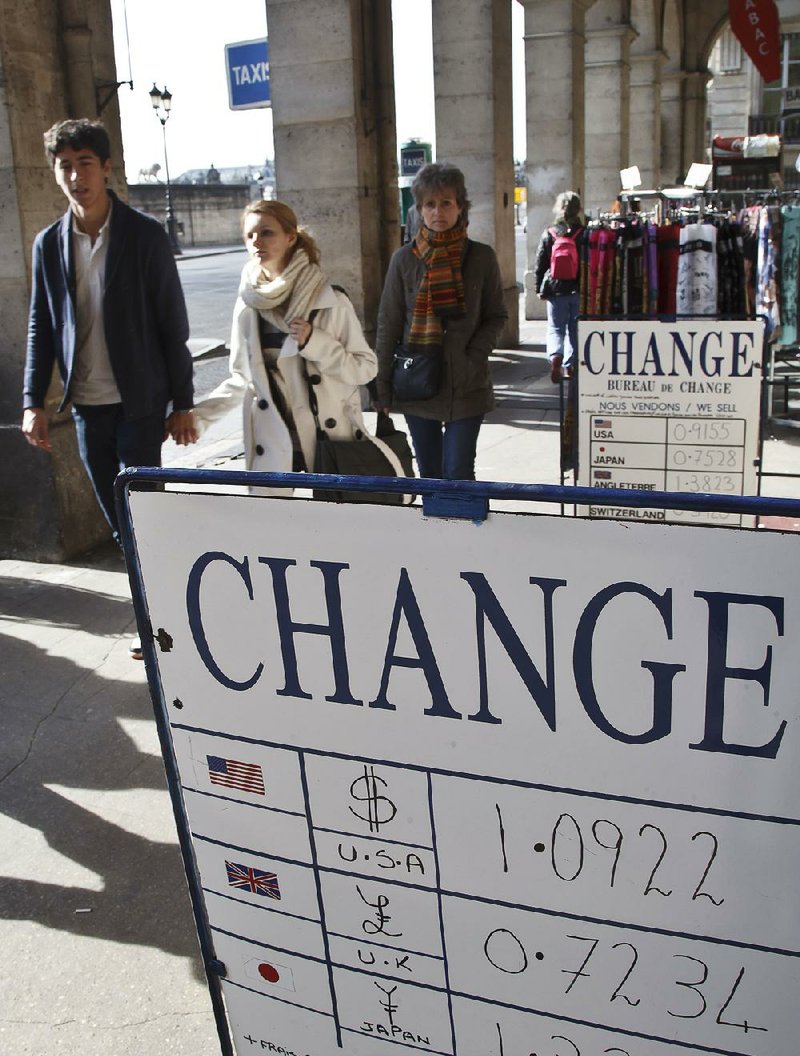LONDON -- The euro's value against the dollar keeps dropping, and it could soon reach parity with the dollar for the first time in 13 years.
Its dramatic decline could help companies in the 19-country eurozone and even be a boon to U.S. tourists by, for example, making it less expensive to buy a trip to the Italian Riviera.
The European single currency has been on the slide since May, when it traded as high as $1.40, while the dollar has been rising across a range of currencies. On Friday, the euro bought $1.0850, the lowest since 2003.
That rapid shift is affecting both sides of the Atlantic.
For U.S. visitors, Europe is getting cheaper. The lower euro means Americans can get more for their buck on an upcoming Easter break to Paris.
Tour companies in Greece are already reporting stronger interest from U.S. travelers.
That is welcome news for European economies, many of which count on tourism for jobs and revenue. Greece earns around a fifth of its money from tourists.
"The cheap euro makes Greece more attractive, and we have a very positive picture from the U.S.," said Andreas Andreadis, head of the Association of Greek Tourist Enterprises.
In the longer term, the main effect of the weaker euro will likely emerge as companies plot their investment and sales strategies.
Big European exporters of high-value goods, which are particularly numerous in the region's large economies such as Germany, stand to benefit. Those that are based in the U.S. and sell in Europe will get pinched.
Anke Rindermann, a senior analyst at Moody's, said the euro's fall "will be positive for companies that have the majority of their cost bases in the euro area and significant sales to regions outside it."
Carmakers BMW, Daimler and Volkswagen all fall in that category, she said, as they export a high proportion of their production to the U.S.
The impact is not the same for all companies, though. European airlines, for example, could be hurt, as most of the rising demand for travel to Europe would likely be captured by non-European airlines.
The euro has been falling mainly because of the divergence in economic performance between the eurozone and the United States. Where the eurozone's recovery from the global financial crisis has been at best anemic, the U.S. economy appears to be going from strength to strength.
The currency movements are mainly driven by the actions of central banks. While the European Central Bank has lowered interest rates and started a massive money-creating stimulus, effectively diluting the value of the euro, the U.S. Federal Reserve is doing the opposite. It is preparing to raise interest rates after deciding last year to end its own stimulus program.
Friday's forecast-busting U.S. jobs report highlighted that divergence. It ratcheted up expectations that the Fed would start raising interest rates as soon as June, prompting a flurry of dollar buying. How quickly the euro and dollar get to a 1-to-1 value will depend on market fluctuations.
"After such a strong, sustained downtrend, the road to parity may not be a straight line," said Kathleen Brooks, research director at Forex.com.
Since its introduction in 1999 at a rate just below $1.18, the euro has spent most of its time above current levels.
In its early days, the euro was relatively friendless, and in late 2000, the European Central Bank and other central banks intervened in the markets to prop up the ailing currency, which at one stage fell to a low of a little over $0.82.
That appeared to help and the euro staged a rebound, pushing back above parity with the dollar in late 2002. By the summer of 2008, just before the global financial crisis took a particularly damaging turn with the collapse of U.S. investment bank Lehman Brothers, it struck its all-time high just above $1.60.
Information for this article was contributed by Jamey Keaten of The Associated Press.
Business on 03/07/2015
